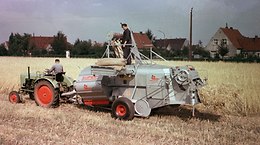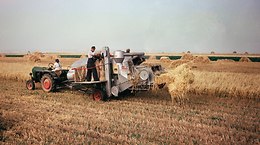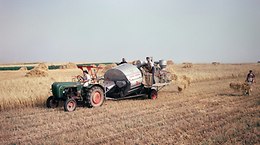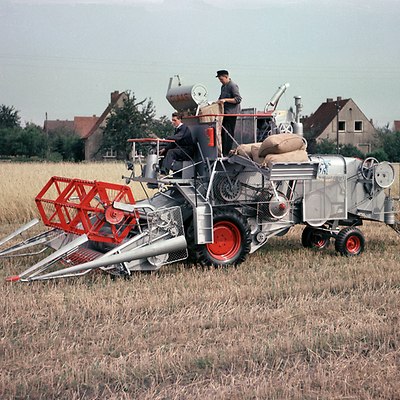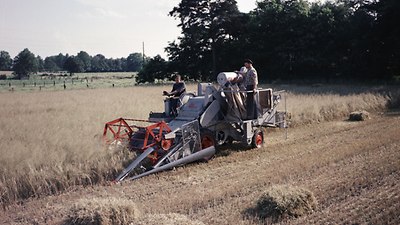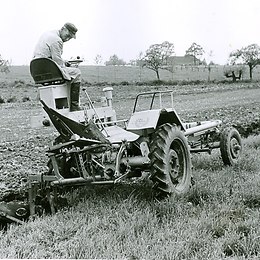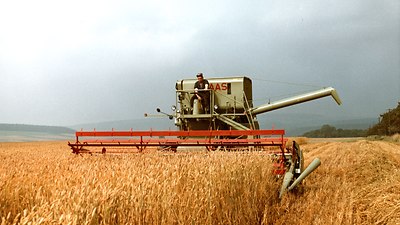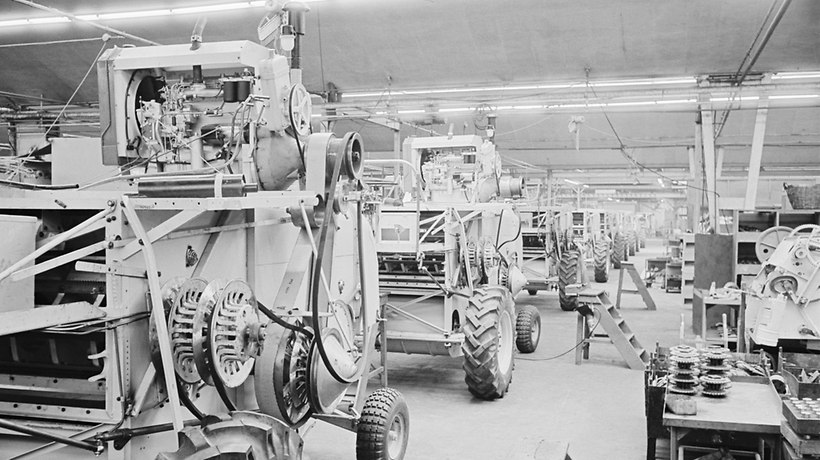

The CLAAS combine harvester story
In 1930, Professor Vormfelde suggested to the Claas brothers that they should develop the first European combine harvester, and, in 1936, they brought the first combine harvester specifically designed for European conditions onto the market. After the Second World War, CLAAS achieved the breakthrough in the combine harvester sector with its trailed SUPER machine.
1936
The mower-thresher-binder (MDB)
The birth of the CLAAS combine harvester: with the mower-thresher-binder (MDB), CLAAS successfully launched the first operational combine harvester specifically designed and built for European harvesting conditions. The foundation was thus laid for the ongoing manufacture of combine harvesters at CLAAS. The very first machine, sporting the machine No. 1, was delivered to the Zschernitz estate in the Halle/Saale region in time for the harvest of 1936. The cross-flow combine harvester MDB was a combination of a self-binder and a threshing mechanism, with the threshing mechanism housed between the cutterbar and the binder. After chopping, the grain was delivered to the threshing drum via a feed belt, and the straw was re-routed by a chain conveyor and fed to the straw walker. The crop then passed through two cleaning phases before the grain was filled into sacks and the straw tied into bunches. The MDB entered series production in 1937. Before production was ceased in 1943, owing to the war, around 1,400 machines of this model had been built.
1946
SUPER
However, the mower-thresher-binder with the cross-flow configuration had soon reached the limits of its capacity. From as early as 1942, CLAAS began development work on a combine harvester based on the transverse and longitudinal flow process, where the grain is threshed in a cross-flow operation, and then conveyed out of the machine in the longitudinal direction. During its development, this device was referred to as the “super-type mower-thresher-binder”, and it duly went into production from 1946 as the SUPER.
With the trailed SUPER and its little brother, the JUNIOR (from 1953), CLAAS made the combine harvester a viable proposition for farmers in Europe. The SUPER combine harvester featured a revolutionary lightweight design, and was constantly reworked and enhanced as time went on. From 1958, for example, it was fitted with a leading-edge hydraulic control system, called the AUTOMATIC. This allowed the driver to use a hydraulic device on the tractor to control the basic settings of the combine harvester attached to the rear.
Over the years, the SUPER continued to impress the firm’s customers with its performance, economy and reliability. When the machine finally went out of production in 1978, more than 65,000 units of the SUPER combine harvester family had been produced in Harsewinkel.
1953
HERCULES – the first self-propelled machine
With production of the highly successful trailed combine harvester SUPER still under way, CLAAS set about developing a self-propelled combine harvester to add to its line-up. To mark the 65th birthday of company founder August Claas, the first self-propelled CLAAS combine harvester, the HERCULES, was unveiled on 15 December 1952. The CLAAS self-propelled machine operated according to the longitudinal flow principle. All components such as the hydraulics and air-cooled four-cylinder engine were developed and built by the company itself.
When it was found that the HERCULES name was already in use elsewhere, in the same year the product was launched, the new harvester was renamed the “SF”, standing for “Selbstfahrer“, the German word for “self-propelled”. The SF impressed firstly with its working width of up to 4.20 m, maintained even in the most difficult harvesting conditions.
But it was also an amazingly versatile performer. Along with the more familiar grain crops, the SF also coped effortlessly with peas, rapeseed, maize, clover, grass seeds and other special crops. The productivity and versatility of the SF was aimed above all at large farms and contractors. The CLAAS SF successfully laid the foundations for the firm’s subsequent self-propelled combine harvesters.
1957
HUCKEPACK – an all-purpose system
The CLAAS HUCKEPACK was a self-propelled combine harvester based on the longitudinal flow process, with a working width of 2.10 m. The point of difference of the HUCKEPACK was that outside the harvesting season it could be turned into an implement carrier, for even fuller use of the machine’s capacity. The HUCKEPACK was aimed at making self-propelled harvesters an economic proposition for smaller farms as well. The conversion of the HUCKEPACK from combine harvester to implement carrier was a two-person job, taking around half an hour. In combine harvester mode, the steering axle was at the rear, and the driver’s seat had to be rotated 180°. This meant that the fixed pedals were the opposite way around for the driver. As an implement carrier, the CLAAS HUCKEPACK was a truly versatile device. The implement carrier had a patented chassis with removable longitudinal member. All the usual tractor implements could be mounted between the axles, and operated with hydraulic spool valves. The HUCKEPACK had a three-point hydraulic system, plus a standard PTO and path-dependent PTO. The HUCKEPACK principle was ultimately unsuccessful on the market, however, and, accordingly, the machine went out of production as early as 1960. This was mainly because of the lack of quick-attachment systems for hydraulics, electrical devices and PTOs, which came into widespread use only many years later.
1958
COLUMBUS / EUROPA / MERCUR – a combine harvester for any farmer
The EUROPA and COLUMBUS were combine harvesters designed mainly for smaller farms, which in many cases were still using stationary threshing machines. The threshing mechanism of the HUCKEPACK was reused for the EUROPA, which was produced in Harsewinkel from 1958. The COLUMBUS followed one year later as a smaller version, with the cutting width trimmed back from 2.10 m to 1.80 m. Both models were relatively small in comparison with the SF, but with leading-edge equipment for the time, including hydraulic controls for the cutterbar and reel. Both of these combine harvesters became big sellers for CLAAS, and a combined total of over 60,000 units were produced. 1964 saw the market launch of the CLAAS MERCUR, a combine harvester designed to fill the gap between the COLUMBUS and EUROPA as smaller machines, and the successor of the SF, the MATADOR. While very similar to the two smaller models in its external appearance, the MERCUR had four rather than three straw walkers, and a threshing drum width of 1,060 mm instead of 800 mm.
| Product | Brochure |
| COLUMBUS | Download |
| EUROPA | Download |
| MERCUR | Download |
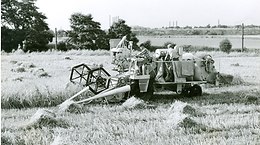
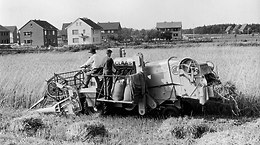
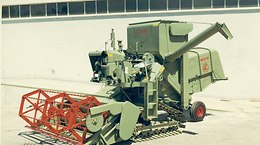
1962
MATADOR – large combines with gigantic dimensions
With the MATADOR CLAAS continued the era of the large-scale combine harvester. Increasing rationalisation in the agricultural sector called for higher-performance and more modern large combine harvesters. The MATADOR, with its 6-metre working width, was literally a giant for its time. The MATADOR was initially marketed in a version with 87-hp diesel engine, a straw walker area of 4.5 m2 and a grain tank with 2,690-litre capacity with attachment. When it was found that there was also a demand for a smaller machine, the MATADOR STANDARD was developed. The new variant was similar to the existing MATADOR in many ways, but had a smaller 68-hp four-cylinder engine, shorter straw walkers and a smaller grain tank volume. The original version of the MATADOR was now given the suffix GIGANT to indicate its larger dimensions. In total, more than 35,000 MATADOR combine harvesters were built in the production years 1962–70.
| Product | Brochure |
| MATADOR | Download |
| MATADOR GIGANT | Download |
| MATADOR STANDARD | Download |



